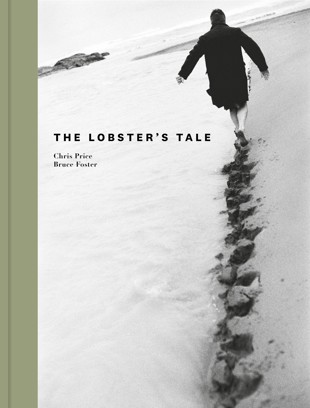Don Abbott, deputy editor of Art New Zealand, has reviewed The Lobster's Tale in the Summer ‘22 issue.
‘The cover of The Lobster’s Tale provides a perfect precursor of its contents — a bleak midwinter beach game speaks of the sea, nature, solitude, horizons and textures, but also, punningly, of the text it is beside: the footsteps on the edge of a river’s beach-based sandbank look spookily like the scales of a lobster’s tail. This is the third in the kōrero series from Massey University Press, a project instigated by Lloyd Jones, one that intends to produce picture books for grown-ups, by fostering collaborations between literary and visual artists.
Inside, the crustacean provides the starting point for Chris Price’s textual meanderings, and she takes the reader through a series of considerations about and around the lobster. Aspects include its anatomy, its migration, its various scientific types, its predators, its DNA and its culinary value. But Price casts her net wide and comments on the lobster as it appears in both art — specifically in Tupaia’s painting of a lobster being transacted between a Māori man and Joseph Banks — and literature. The writing of Camus provides subject matter, as does the voyage made by Jonathan Franzen to the Atlantic island of Alejandro Selkirk, where he scattered some ashes of his cremated friend and fellow novelist David Foster Wallace; it all allows ideas and threads to bubble and ferment, appearing above and simmering below the surface, constructing a web of thought, like a pot around a crayfish.
Price is known best as a poet. Here her writing is delightful, full of wit and intelligence. It comes with a natural authorial ease, peppered with the elements of linguistic surprise that might come from a poet’s toolbox; it has a levity that makes her insights both poignant and profound.
Interspersed throughout this text are photographs by Bruce Foster, many of which, though not all, are to do with water — the sea, the beach, pools, algae. The interplay with Price’s text is playful and sophisticated, varying from overt to obscure. The photographs are engaging — they date from over 30 years — and show Foster’s command of visual language, from street and landscape through to fine art and abstract photography. The sequence of images also follows its own logic, so that the publication can be read in a variety of ways: as a book of words, or pictures, or both.
A further prose poem occupies a line near the bottom of every text page; the notes at the back of the book call this a “below-the-waterline” paragraph. It contains “material adapted from” American explorer and naturalist William Beebe’s 1935 Half Mile Down, an account of deep-sea dives in a submersible in Bermuda in the 1930s. To read and comprehend this below-the-waterline text it is necessary to reread the book from page one. Foster’s images get to relate to a second textual context, and they carry a new, different weight. The book becomes a subtle, enjoyable, multifaceted lesson in how to read images, and how to expect and accept their ability to shift and morph. Reading The Lobster’s Tale may well change the way you read images everywhere.
As with its two earlier stablemates The Lobster’s Tale benefits from a clear and stylish layout, and everybody involved should thank designer Gary Stewart for making them look so good. The bookshelves of the nation should join the party. In the meantime, the next volume in Massey University Press’ kōrero series is due out next year.’


